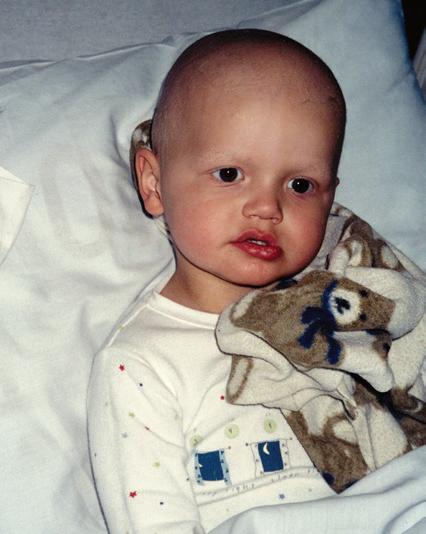
3 minute read
research
you are bringing hope to children with cancer
Campbell was two when he started fussing while in his car seat. If Mom or Dad didn’t angle the car seat just right, his legs would fall asleep and he would start screaming. They thought it was a bit bizarre but they also thought, “He’s two, and two-year-olds can be impossible.”
It wasn’t until they were visiting Grandma Marian one spring day that they began to realize the severity of the problem. Running across the living room, Campbell fell and wasn’t able to get up and walk. His mom’s nurse’s intuition was screaming, so she took Campbell to the Alberta Children’s Hospital, where a bone scan revealed a grapefruit-sized tumour on the adrenal gland of his right kidney. There were also tumours along his femurs, pelvis, ribs and neck. Campbell was diagnosed with stage 4 neuroblastoma and Ken and Jennifer Laidlaw learned that their two-year-old son had only a five to 10 per cent chance of making it. That was 10 years ago, and although Campbell survived, 70 per cent of children with highrisk neuroblastoma do not. This is after enduring treatment protocols similar to Campbell’s. Scientists still do not understand why only 30 per cent of children with highrisk neuroblastoma survive and why 15 per cent fail to respond to treatment at all. Dr. Paul Beaudry* is trying to change this. With the help of a $300,000 Kids Cancer Care research award, made possible by you, Dr. Beaudry is investigating three new approaches to diagnosing and treating neuroblastoma.
1. Cancer-killing viruses
Researchers in Dr. Beaudry’s lab are investigating viruses known for attacking cancer cells, while leaving healthy cells alone and boosting the immune system to fight cancer. With your support, these researchers are systematically testing for viruses that show promise for treating neuroblastoma.
2. Metabolomics
Using the science of metabolomics, a system for measuring the metabolites (molecules) of a person’s cells to determine their overall health status for different diseases,
Dr. Beaudry is learning to predict which children will survive with less therapy and which high-risk children will not respond to therapy at all – hopefully, all with a simple blood test one day.
3. Resistant molecules
With your support, these researchers are also beginning to identify rogue molecules that help neuroblastoma cells resist treatment. By understanding how these molecules work,
Dr. Beaudry hopes to uncover the secrets of destroying them. Today, Campbell is a healthy teenage boy who loves golfing and freestyle skiing. As with most childhood cancer survivors, however; Campbell lives with long-term side effects of treatment. He has serious hearing deficits and, at 14, he’s already wearing high-powered hearing aids, which he hides with his long, freestyleskier hair. Campbell is also missing many adult teeth and requires extensive orthodontic work, jaw surgery and implants. Dr. Beaudry hopes to create a better future for kids like Campbell by improving their chances of surviving and by developing targeted therapies that cause fewer long-term side effects. His hope is that, one day, with your help, no child will ever face the odds Campbell did.
60+
new children’s cancer research studies are in the works because of you.
Although Campbell survived, 70% of kids with high-risk neuroblastoma do not. Dr. Paul Beaudry is trying to understand why.
you are here improving the odds for kids
Thank you! With your support, Kids Cancer Care made another $300,000 gift to the experimental and applied therapeutics program at the University of Calgary and Alberta Children’s Hospital, where there are currently more than 60 new research studies in the works.
2013 / ANNUAL REPORT 2012 / CER CARE FOUNDATION OF ALBERTA | CAMP SUNMAKER | RESEARCH | KIDS CAN HOSPITAL PROGRAMS | SCHOLARSHIPS | FUNDRAISING | CAMP KINDLE | PIZZA NIGHT | FAMILY







